guidance, flight mechanics and trajectory optimization
guidance, flight mechanics and trajectory optimization
guidance, flight mechanics and trajectory optimization
Create successful ePaper yourself
Turn your PDF publications into a flip-book with our unique Google optimized e-Paper software.
2.2.3 Maximum - Minimum Problem<br />
In order to demonstrate the more analytical applications of Dynamic<br />
Programmin g, a simple Maxima-Minima Problem will be examined. The procedure<br />
utilized to formulate a problem for the application of Dynamic Programming<br />
is not always immediately obvious. Many times the problem formulation for<br />
a Dynamic Progr amming solution is quite different from any other approach.<br />
The following problem will be attacked in a manner such that the Dynamic<br />
Programming formulation <strong>and</strong> method of attack can be seen.<br />
The problem is to minimize the expression<br />
subject to the constraints<br />
K, + A-- f x3 = /o<br />
(2.2.22)<br />
(A problem similar to this is often used by Dr. Bellman to introduce the<br />
concepts of Dynamic Programming). At first glance, the methods of Dynamic<br />
Programming do not seem to apply to this problem. However, if the problem<br />
is reduced to several smaller problems, the use of Dynamic Programming<br />
becomes apparent. Consider the minimization of the following three functions:<br />
$ = xf (2.2.23)<br />
4 = ( +2*; (2.2.24)<br />
Applying the constraintsix = 10, x. 1 Otto th e first function give3 the<br />
trivial result xl = 10. T k is resulg is not so helpful. However, if the<br />
constraints<br />
x, = A I 0 4 A, L /o<br />
x, 2 0<br />
35<br />
(2.2.25)

















